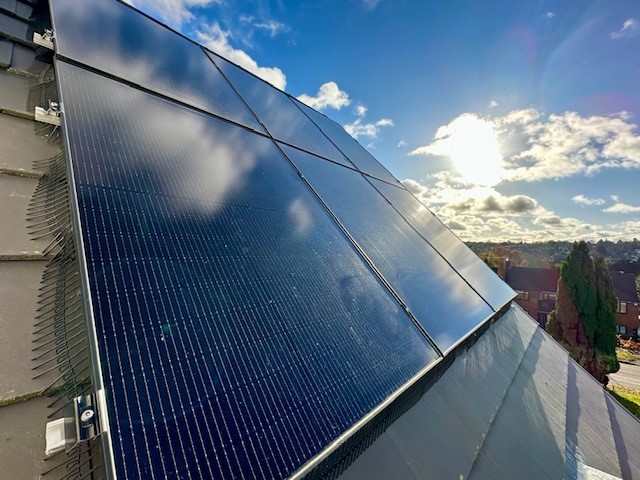Last year installed 7.5 kW of solar on my house and I’ve been positively surprised by the savings its brought me despite the dreary British climate. The sun has been used by humans for centuries as an energy source and today, solar photovoltaic (PV) technology allows us to convert sunlight directly into electricity, offering a clean and renewable energy solution. In this article, we’ll delve into how solar panels work, explore the history of solar PV, discuss current technologies, highlight cost reductions, and examine the accelerating global deployment of solar power.
A Brief History of Solar Photovoltaics
- 1839: French physicist Edmond Becquerel discovered the photovoltaic effect, observing that certain materials produce electric currents when exposed to light.
- 1873: Willoughby Smith found the photoconductivity of selenium, paving the way for solar experimentation.
- 1883: American inventor Charles Fritts created the first working solar cell using selenium wafers, achieving less than 1% efficiency.
- 1954: Bell Labs developed the first practical silicon solar cell with 6% efficiency, marking the birth of modern solar PV technology.
- 1960s-1970s: Solar cells powered space satellites, demonstrating reliability in extreme conditions.
- Late 20th Century: Advances in materials and manufacturing reduced costs and improved efficiencies, making solar panels accessible for residential and commercial use.
How Do Solar Panels Work?
Solar panels convert sunlight into electricity through the photovoltaic effect:
- Light Absorption: Solar cells within the panels are made of semiconductor materials, typically silicon. When sunlight hits the cell, photons are absorbed, exciting electrons.
- Electron Movement: The energy from the photons knocks electrons loose, allowing them to flow freely.
- Electric Field Creation: Solar cells are designed with positive (p-type) and negative (n-type) layers, creating an electric field that directs the flow of electrons.
- Current Generation: The movement of electrons through the external circuit generates direct current (DC) electricity.
- Power Utilization: An inverter converts DC into alternating current (AC) for use in homes and businesses or for feeding into the power grid.
Current Solar PV Technologies
- Monocrystalline Silicon Panels: Made from single-crystal silicon, these panels offer high efficiency (15-22%) and a sleek appearance.
- Polycrystalline Silicon Panels: Composed of multiple silicon crystals, they are cost-effective with moderate efficiency (13-17%).
- Thin-Film Solar Cells: Utilize materials like cadmium telluride or amorphous silicon, are flexible, and perform better in low-light conditions but have lower efficiency (10-12%).
- Emerging Technologies:
- Perovskite Solar Cells: Promising high efficiency and low production costs; still under development for commercial viability.
- Bifacial Panels: Capture sunlight from both sides, increasing energy production.
The Decline in Solar Costs
Over the past decade, the cost of solar panels has dramatically decreased:
- Economies of Scale: Mass production and increased demand have reduced manufacturing costs. China has developed vast stakes in the solar supply chain from raw materials to cell production. The vast majority of solar is now produced in China.
- Technological Advancements: Improved efficiency and material usage lower the price per watt.
- Global Investment: Significant investments and governmental incentives have spurred industry growth especially on demand side in Europe.
According to the International Renewable Energy Agency (IRENA), the cost of electricity from utility-scale solar PV fell by a staggering 85% between 2010 and 2020.

Accelerating Global Deployment of Solar PV
The future of solar energy is bright (pun intended), with several factors driving its rapid expansion:
- Residential Growth: Homeowners are installing rooftop solar panels to save on energy bills and reduce carbon footprints.
- Commercial Adoption: Businesses are leveraging solar to meet sustainability goals and lock in energy costs.
- Government Policies: Incentives and renewable energy targets encourage solar installations.
- Technological Innovation: Advancements in storage solutions and smart grid technology enhance solar’s reliability.
- Temporal resonance: California and other hot locations is a great example where solar generation matches well with the demand – when it’s hot, AC is on requiring power which is in abundance.
BloombergNEF reports that global solar capacity could reach over 2,000 gigawatts by 2030, doubling current levels.
Conclusion
Solar PV technology is now a cornerstone of global energy strategy. With continued technological improvements and cost reductions, solar power is set to play a pivotal role in a sustainable energy future. The accelerating deployment in both residential and commercial sectors underscores a collective commitment to harnessing the sun’s power for a cleaner, brighter world. The role of BESS (Battery Energy Storage Systems) is a key enabler of this too ensuring solar energy can be used when it’s needed. That is a different story…

